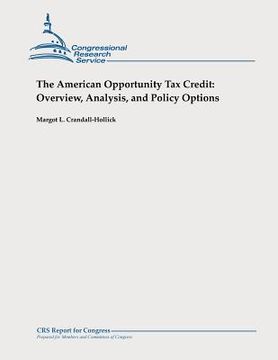The American Opportunity Tax Credit: Overview, Analysis, and Policy Options (en Inglés)
Reseña del libro "The American Opportunity Tax Credit: Overview, Analysis, and Policy Options (en Inglés)"
The American Opportunity Tax Credit (AOTC)-enacted on a temporary basis by the American Recovery and Reinvestment Act (ARRA; P.L. 111-5) and extended through the end of 2012 by the Tax Relief, Unemployment Insurance Reauthorization, and Job Creation Act of 2010 (P.L. 111-312)-is a partially refundable tax credit that provides financial assistance to taxpayers who are attending college, or whose children are attending college. The credit, worth up to $2,500 per student, can be claimed for a student's first four years of post-secondary education. In addition, 40% of the credit (up to $1,000) can be received as a refund by taxpayers with little or no tax liability. The credit phases out for taxpayers with income between $80,000 and $90,000 ($160,000 and $180,000 for married couples filing jointly) and is hence unavailable to taxpayers with income above $90,000 ($180,000 for married couples filing jointly). There are a variety of other eligibility requirements associated with the AOTC, including the type of degree the student is pursuing, the number of courses the student is taking, and the type of expenses which qualify. Prior to the enactment of the AOTC, there were two permanent education tax credits, the Hope Credit and the Lifetime Learning Credit. The AOTC temporarily replaced the Hope Credit from 2009 through the end of 2012 (the Lifetime Learning Credit remains unchanged). A comparison of these two credits indicates that the AOTC is both larger-on a per capita and aggregate basis-and more widely available in comparison to the Hope Credit. Data from the Internal Revenue Service (IRS) indicates that enactment of the AOTC contributed to a more than doubling of the amount of education credits claimed by taxpayers. Education tax credits were intended to provide federal financial assistance to students from middle-income families, who may not benefit from other forms of traditional student aid, like Pell Grants. The enactment of the AOTC reflected a desire to continue to provide substantial financial assistance to students from middle-income families, while also expanding the credit to certain lower- and upper-income students. A distributional analysis of the AOTC highlights that this benefit is targeted to the middle class, with more than half (53%) of the estimated $16 billion of AOTCs in 2009 going to taxpayers with income between $30,000 and $100,000. One of the primary goals of education tax credits, including the AOTC, is to increase college attendance. Studies analyzing the impact education tax incentives have had on college attendance are mixed. Recent research that has focused broadly on education tax incentives that lower tuition costs and have been in effect for several years, including the Hope and Lifetime Learning Credits, found that while these credits did increase attendance by approximately 7%, 93% of recipients of these benefits would have attended college in their absence. Even though the AOTC differs from the Hope Credit in key ways, there are a variety of factors that suggest this provision may also have a limited impact on increasing college attendance. In addition, a recent report from the Treasury Department's Inspector General for Tax Administration (TIGTA) identified several compliance issues with the AOTC. There are a variety of policy options Congress may consider regarding the AOTC, including extending the credit, extending a modified AOTC, or repealing the Hope and Lifetime Credits and extending a modified AOTC that includes provisions included in these credits. Alternatively, Congress may want to examine alternative ways to reduce the cost of higher education.

